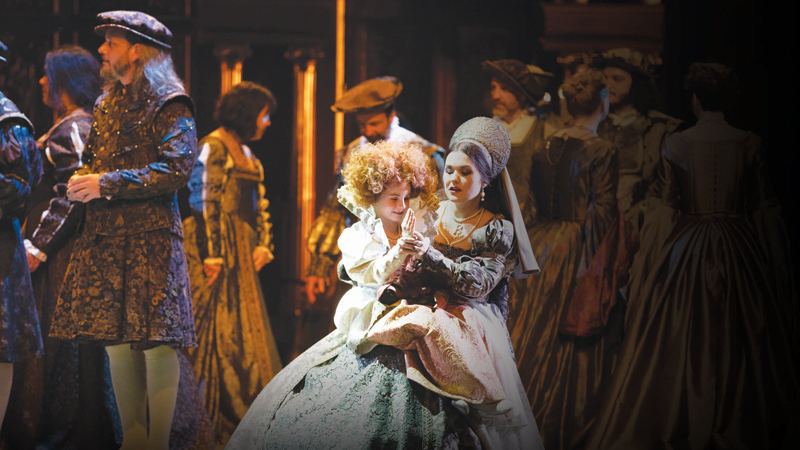


The much awaited production of Donizetti’s 1830 Tragic Opera, ‘Anna Bolena’ was performed twice at the weekend with a star spangled cast of international soloists.
The three-hour venture in two Acts was created in Belgium by the Opéra Royal de Wallonie-Liège in co-production with the Royal Opera House, Muscat. The premiere of this production, directed by Stefano Mazzonis di Pralafera with gorgeous period costumes designed by Fernand Ruiz was given in the Opéra de Lausanne in Switzerland in February this year. Donizetti was fascinated by the English Queens, and the storyline and characters remain faithful to history, with some romantic liberties taken for dramaturgical effect.
Thursday was the debut performance of internationally renowned Uruguayan Bass-baritone, Erwin Schrott in the role of King Henry the Eighth, his second visit to ROHM after his highly acclaimed appearance in ‘Rojotango’ presented with Placido Domingo in 2015. The auditorium was hushed in anticipation of Italian conductor, Giampaoloa Bisanti with the sixty-strong members of the orchestra in the pit – their second time in Muscat since Bizet’s, ‘Pearl Fishers’ in May 2017. On the front curtain was a huge portrait of Anne Boleyn, second wife of Henry VIII and first to be executed. The Overture was delicately poised with some lyrical woodwind playing surprisingly light, rhythmic melodies for such a dark subject. Towards the end of the Overture a glimpse of Enrico (Henry) in his bedroom with Giovanna (Jane Seymour) gave a hint to the backstory of an affair. The colourful, lavish brocade costumes and dark sets (British Designer, Gary McCann) of Windsor Castle were cleverly matched in subtle lighting, giving an authentic context for the last days of the fated queen in 1536. Sixteen men of the Chorus were the first to sing, courtiers commenting on Henry’s liaison with Lady Jane and the implications for Anne, a sound full of rich colour.
In Queen Anne’s apartments, the appearance of Giovanna in a moving, plaintive Aria full of remorse was performed beautifully by Ukrainian Soprano, Sofia Soloviy. Anne Boleyn arrived with her daughter, the future Queen Elizabeth, played by a local child extra in an inventive touch from Pralafera. Anna’s aria, accompanied by a gentle harp solo (Célia Perrard) was lyrically phrased by Russian Soprano, Olga Peretyatko in Donizetti’s iconic high coloratura style as she recalled happier times with her first love, Lord Richard Percy. Anna warned Jane of the dangers of being dazzled by royal allure in a moving soprano duet. As a result Jane tried to stop seeing King Henry, but Erwin Schrott’s rich, warm baritone timbre assured her that she would soon be queen herself. His dramatic, powerful voice never faltered for a moment throughout the opera and here the ensemble with Soloviy was sublime.
Scene three in a wood featured an orange blossom tree descending from the flies during the ‘Interlude’, which shed dappled shading across the stage. There was agitated recitative between the youthful and brilliant Russian tenor, Maxim Mironov entering as Lord Riccardo Percy with Anne’s brother, Lord Rochefort, performed by the secure and confident Italian Bass, Luciano Montanaro. Percy’s Cavatina and Cabaletta, “Da Quel dì che, lei perduta....” (From the day that I lost her) in his apparently effortless, clear high register tells of his glad return from exile and palpitations at seeing Anne again. It was expressively agile in true bel canto style, reaching an eye watering top E at its climax! The King’s Hunt was descriptively enchanting with the male chorus as pages and riders and hunting calls from the orchestra, the challenging Horn part sometimes eluding them. Anne and Henry entered with dramatic tension, yet Schrott’s expansive bass quality was always reliable. The unsympathetic character of Sir Hervey, the King’s Spy, was performed by twenty-five-year-old Belgian tenor, Maxime Melnik with measured presence. The scene concluded with a moving Quintet full of pathos, each singing of their conflicting perspectives in a fine ensemble, with commentary from the male chorus.
The following scene in the Queen’s Apartments, complete with gallery above and six candelabras, introduced the naïve Smeton, a court musician enamoured with Anne, and performed by Italian Contralto, Francesca Ascioti. He steals a miniature portrait of the Queen, thus incriminating himself in the web of false charges. He hid and witnessed the entrance of Percy with Rochefort. Anne opened her heart in response to Percy’s beautiful declaration of love, but she warned him how dangerous it is to talk of love in an impossibly high coloratura passage which Ms. Peretyatko performed with stunning control. Interestingly Peretyatko and Mironov sung together at ROHM in 2017 in Rossini’s, ‘L’Ocassione fa un Ladro’. Henry revealed his presence, and the Act concluded with a powerful Sextet and full chorus, each blaming themselves while Enrico condemned them all for high treason.
Act 2 at the Justice Courts set Anne in prayer, overheard by Giovanna, developing into a lengthy dialogue. Soloviy sang the sad, poignant, “Per Questa fiamma indomita... (for this indomitable flame is not extinguished) Ah! Pensate che rivolti”, with its plaintive, falling line and dramatic tension in a brilliant high fioratura cadenza, followed by an exquisite cantabile duet as Anne forgave her rival in one of the evening’s highlights. Later, she pleads with Henry to show mercy in a tender, prayer-like ornamented aria in her high tessitura, commented upon by full chorus.
The scene changed to a Tower of London backdrop and featured the famous Trio, “Arresta, Enrico! T’arresta e m’odi”, in which Percy was brought down to sing farewell to Anna. In the sustained aria at the top of his range, Mironov’s facility was incredibly light yet perfectly projected.
The music in ‘Anna Bolena’ is not all familiar or memorable. There is much dialogue in recitative or bel canto passages, particularly in Act 2, until the famous, “Mad Scene” with its changing moods. Anne hallucinates that her execution is actually her wedding, and she recalls her blissful childhood. A mournful Cor Anglais (Olivier Habran) accompanied, ‘Al dolce guidami’ (take me to the lovely Castle where I was born) in her final soft, poignant Aria, ‘Coppia iniqua’. Donizetti’s score and its stage interpretation were not as dark as some may have anticipated, and the audience was left with an uplifting sense of catharsis.
Oman Observer is now on the WhatsApp channel. Click here



